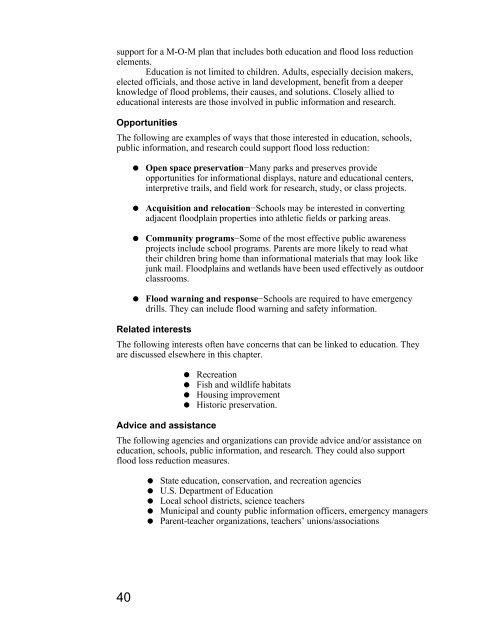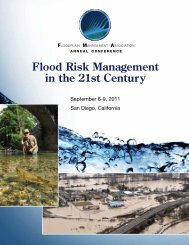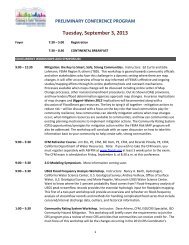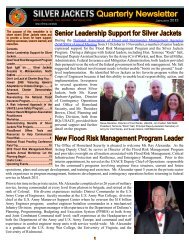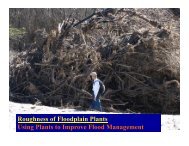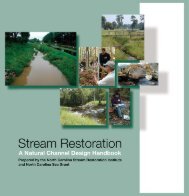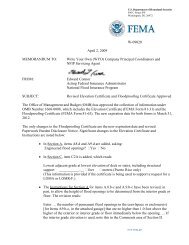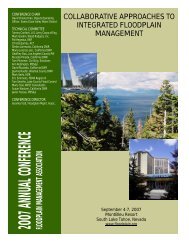Using Multi-Objective Management to Reduce Flood Losses in Your
Using Multi-Objective Management to Reduce Flood Losses in Your
Using Multi-Objective Management to Reduce Flood Losses in Your
You also want an ePaper? Increase the reach of your titles
YUMPU automatically turns print PDFs into web optimized ePapers that Google loves.
support for a M-O-M plan that <strong>in</strong>cludes both education and flood loss reduction<br />
elements.<br />
Education is not limited <strong>to</strong> children. Adults, especially decision makers,<br />
elected officials, and those active <strong>in</strong> land development, benefit from a deeper<br />
knowledge of flood problems, their causes, and solutions. Closely allied <strong>to</strong><br />
educational <strong>in</strong>terests are those <strong>in</strong>volved <strong>in</strong> public <strong>in</strong>formation and research.<br />
Opportunities<br />
The follow<strong>in</strong>g are examples of ways that those <strong>in</strong>terested <strong>in</strong> education, schools,<br />
public <strong>in</strong>formation, and research could support flood loss reduction:<br />
Open space preservation−Many parks and preserves provide<br />
opportunities for <strong>in</strong>formational displays, nature and educational centers,<br />
<strong>in</strong>terpretive trails, and field work for research, study, or class projects.<br />
Acquisition and relocation−Schools may be <strong>in</strong>terested <strong>in</strong> convert<strong>in</strong>g<br />
adjacent floodpla<strong>in</strong> properties <strong>in</strong><strong>to</strong> athletic fields or park<strong>in</strong>g areas.<br />
Community programs−Some of the most effective public awareness<br />
projects <strong>in</strong>clude school programs. Parents are more likely <strong>to</strong> read what<br />
their children br<strong>in</strong>g home than <strong>in</strong>formational materials that may look like<br />
junk mail. <strong>Flood</strong>pla<strong>in</strong>s and wetlands have been used effectively as outdoor<br />
classrooms.<br />
<strong>Flood</strong> warn<strong>in</strong>g and response−Schools are required <strong>to</strong> have emergency<br />
drills. They can <strong>in</strong>clude flood warn<strong>in</strong>g and safety <strong>in</strong>formation.<br />
Related <strong>in</strong>terests<br />
The follow<strong>in</strong>g <strong>in</strong>terests often have concerns that can be l<strong>in</strong>ked <strong>to</strong> education. They<br />
are discussed elsewhere <strong>in</strong> this chapter.<br />
Recreation<br />
Fish and wildlife habitats<br />
Hous<strong>in</strong>g improvement<br />
His<strong>to</strong>ric preservation.<br />
Advice and assistance<br />
The follow<strong>in</strong>g agencies and organizations can provide advice and/or assistance on<br />
education, schools, public <strong>in</strong>formation, and research. They could also support<br />
flood loss reduction measures.<br />
State education, conservation, and recreation agencies<br />
U.S. Department of Education<br />
Local school districts, science teachers<br />
Municipal and county public <strong>in</strong>formation officers, emergency managers<br />
Parent-teacher organizations, teachers’ unions/associations<br />
40


